The year 2025 promises to be a transformative and opportunity-filled period in the field of human resource management. With the deepening integration of AI technologies, shifts toward remote and hybrid work models, and the growing demand for efficiency and employee experience, employee management systems have become indispensable digital tools.
If you are struggling to select the right employee management tool, this article aims to provide valuable insights.

The Importance of Employee Management Systems
- Enhancing Efficiency: Automated processes reduce repetitive tasks such as attendance tracking, payroll calculations, and performance evaluations, saving HR teams significant time and improving overall accuracy.
- Improving Communication and Collaboration: Integrated communication tools like internal chat and announcement modules foster collaboration among departments and employees, accelerating work progress and project execution.
- Data Analysis and Decision Support: By collecting and analyzing employee data, these systems provide precise real-time reports, helping managers make data-driven HR decisions.
- Ensuring Compliance: Systems can provide timely alerts about regulation updates, helping companies fulfill legal obligations and minimize risks.
Key Criteria for Choosing an Employee Management System
- User-Friendliness: Intuitive interfaces and easy-to-operate features reduce learning curves and improve the employee experience.
- Comprehensive Functionality: Systems should cover core areas like recruitment, training, attendance, performance, and payroll, with customizable features to adapt to industry specifics.
- Compatibility: Seamless integration with existing ERP, financial, or project management systems prevents data silos and enhances operational efficiency.
- Data Security and Privacy: Adherence to industry standards ensures the safety and privacy of employee information, reducing risks of data breaches.
- Scalability and Technical Support: As businesses grow, the system should support flexible expansion and provide robust technical assistance for new features or increased user numbers.
Future Trends in Employee Management Systems for 2025
- AI Integration: Artificial intelligence will assist enterprises in improving decision-making efficiency, automating repetitive tasks, and facilitating smoother user interactions through natural language processing.
- Personalized Employee Experience: Systems will use data analytics to offer tailored learning resources, career development paths, and other enhancements, boosting employee satisfaction and productivity.
- Support for Remote and Hybrid Work: New-generation systems will include seamless remote collaboration tools, such as virtual attendance and online meeting scheduling, to adapt to hybrid work environments.
- Advanced Data Security and Compliance: With stricter data protection regulations, systems will focus more on encryption, user access control, and compliance reporting features.
- Health and Wellness Management: Future systems will address stress management and employee mental health by providing data insights and health solutions to improve overall well-being.
- Cross-Platform Integration: Multi-platform support (desktop, mobile, cloud) and integration with third-party tools will enhance operational convenience.
- Dynamic Reports and Visual Analytics: Customizable dashboards and reports will enable HR managers to monitor key performance indicators (KPIs) in real time, optimizing decision-making processes.
How to Select the Right Employee Management System
When selecting an employee management system, businesses should prioritize their unique needs, ensuring the platform effectively supports their goals and workflows. Key evaluation criteria include:
- Core Requirements: Identify employee size, required features, and industry-specific needs to ensure the system meets core demands.
- Technical Compatibility: Focus on whether the system integrates with existing tools (e.g., ERP, financial, or CRM systems) to avoid data silos.
- User Experience: Ensure the system’s usability and design are intuitive, reducing training overhead.
- Budget and ROI: Compare the total costs and additional expenses of each system while evaluating its return on investment.
6 Best Employee Management Systems for 2025
1. NocoBase
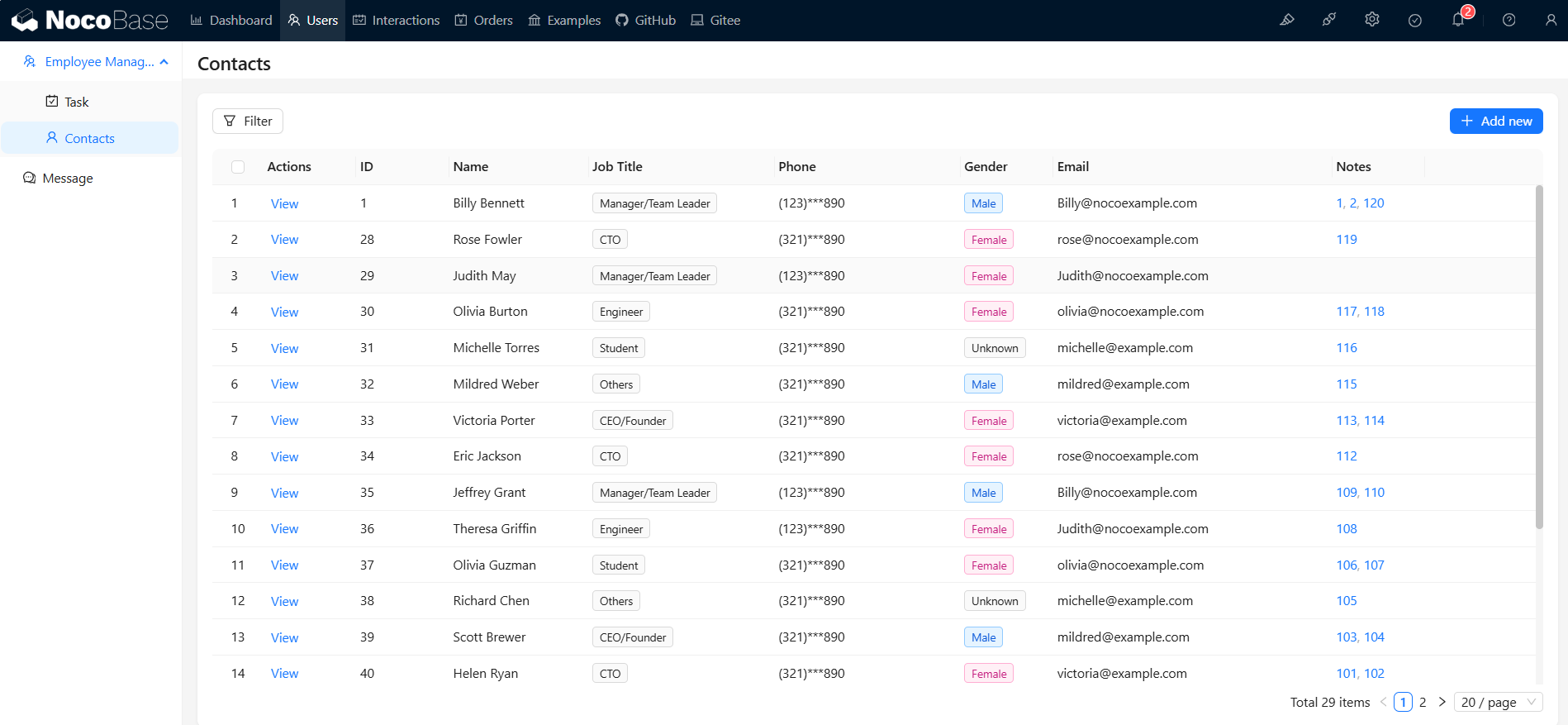
NocoBase is an open-source no-code development platform that supports highly customized and plugin-based extensions, enabling enterprises to quickly build employee management systems.
Core Highlights
- Data Model-Driven: NocoBase adopts a data model-driven design philosophy, allowing users to flexibly define employee data structures based on actual business needs. Whether it is employee basic information, performance evaluation, attendance records, or training plans, data models can be created and adjusted quickly with simple configurations.
- Plugin Architecture: NocoBase’s plugin-based architecture provides robust scalability for businesses. Users can install various plugins as needed to expand system functions, or develop custom plugins to enhance adaptability and flexibility further.
- No-Code/Low-Code Development: NocoBase supports no-code and low-code development, enabling non-technical users to easily get started and quickly build core modules of employee management systems. For teams with technical expertise, low-code development offers greater freedom, allowing complex functions to be implemented with minimal coding.
- Strong Integration Capabilities: NocoBase features powerful integration capabilities, seamlessly connecting with other enterprise systems, such as HRMS and ERP, via API interfaces or data source connections, achieving real-time data synchronization and interaction.
Use Cases
- Employee Records Management: Supports the creation of flexible employee information management systems, with customizable fields and access settings, enabling efficient management of employee records.
- Performance Evaluation and Analysis: By combining data models with automation, businesses can customize performance evaluation metrics, track employee performance in real time, and generate analytical reports to support decision-making.
- Work Hours and Shift Management: Allows for customized work schedules and shift arrangements, achieving accurate work hour recording and shift management, avoiding conflicts, and improving efficiency.
2. BambooHR
BambooHR is an HR software that simplifies employee data management, recruitment, payroll, performance, and employee experience tools.
Core Highlights
- All-in-one HR Platform: BambooHR integrates all HR systems into one platform, unifying payroll, attendance, and benefits management operations.
- Custom Reports and Analytics: Offers instant pre-built reports, automated workflows, and deep analysis tools to identify potential issues, such as turnover rates and work hour allocation, optimizing HR strategies.
- Mobile Support: Provides a robust mobile application, enabling administrators and employees to access the platform anytime, anywhere, to handle leave requests, view payroll records, or update personal information.
Use Cases
- Employee Onboarding and Records Management: Simplifies the onboarding process with customizable forms and templates, creating detailed employee records and supporting document uploads and permission management.
- Leave and Attendance Management: Employees can apply for leave online and check their balances, while managers can approve requests in real-time, automatically syncing attendance records.
- Performance Evaluation and Feedback: Built-in performance management modules allow businesses to customize assessment metrics, set goals for employees, and provide regular feedback, helping employees achieve career development goals.
3. Workday
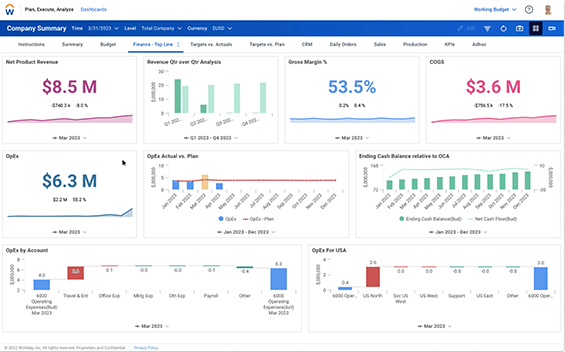
Workday offers a cloud-based solution integrating HR, financial management, and analytics for efficient operations and decision-making.
Core Highlights
- Innovative Ecosystem: Workday creates an innovative ecosystem combining the expertise of its partners, clients, and itself to build future-oriented solutions.
- Advanced AI Technology: Through its AI platform Workday Illuminate™, Workday significantly enhances work efficiency and decision-making capabilities.
- Unified Data Architecture: Employs a unified data architecture, delivering continuous innovation and improvements quickly, showcasing superior agility and adaptability.
Use Cases
- Global Employee Management: Provides a unified employee data management platform for multinational companies, reducing complexities in cross-border business.
- Payroll and Benefits Management: Supports complex payroll structures and diverse employee benefits policies while ensuring compliance, ideal for complex business environments.
- Talent Development and Succession Planning: Tracks employee skills and career development goals, helping businesses develop talent strategies and identify potential successors for critical roles.
4. SAP SuccessFactors
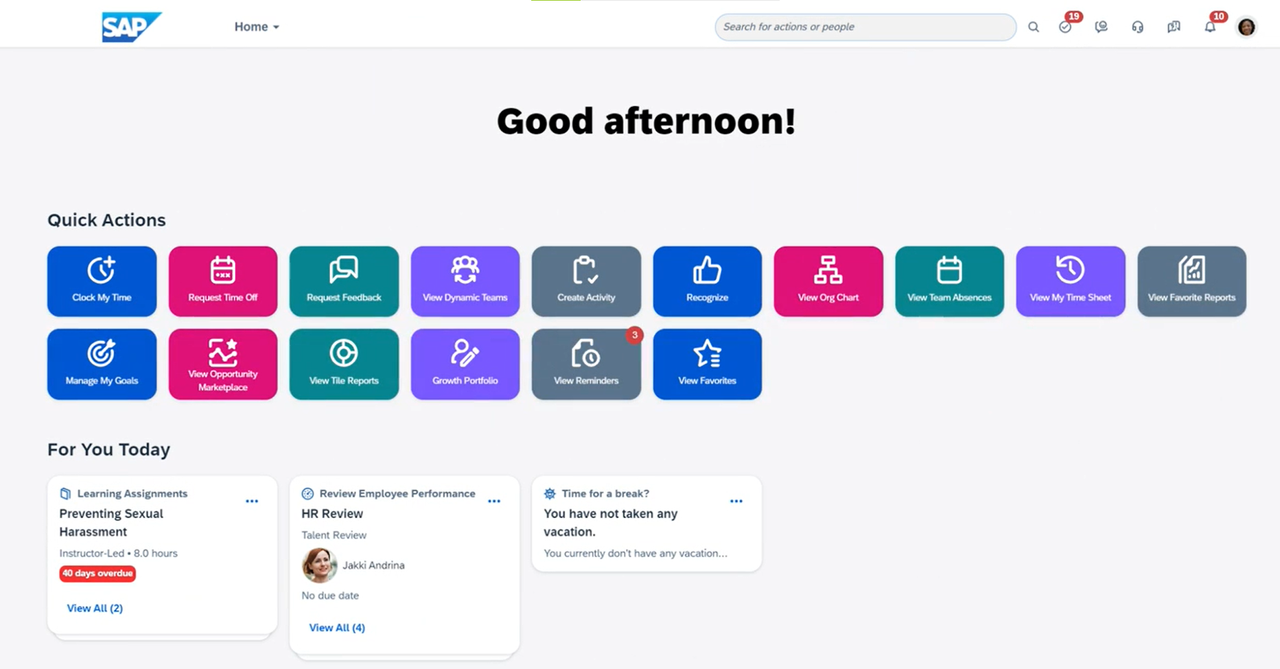
SAP SuccessFactors is a comprehensive cloud-based human capital management (HCM) solution that integrates talent management, core HR, analytics, and employee experience functionalities.
Core Highlights
- AI-Driven Intelligent Management: Leverages AI technology for HR self-service, learning and development, performance management, and more, boosting employee efficiency.
- Unified Talent Data Platform: Provides a single source of personnel and skills data, integrating HR and talent data from various departments for a holistic view.
- Compliance and Localization Support: Ensures global compliance with built-in updates on legal regulations and adapts to local business requirements, reducing compliance risks.
Use Cases
- Talent Management: Offers robust talent intelligence, recruitment, onboarding, performance, compensation, learning, and succession management features to quickly address skill gaps.
- Employee Experience Management: Provides accessible work resources, gathers employee feedback, and fosters engagement and loyalty through exceptional experiences.
- HR Analytics and Planning: Uses data-driven talent insights, workforce planning tools, and AI-driven suggestions to optimize decisions and enhance overall performance.
5. Zoho People
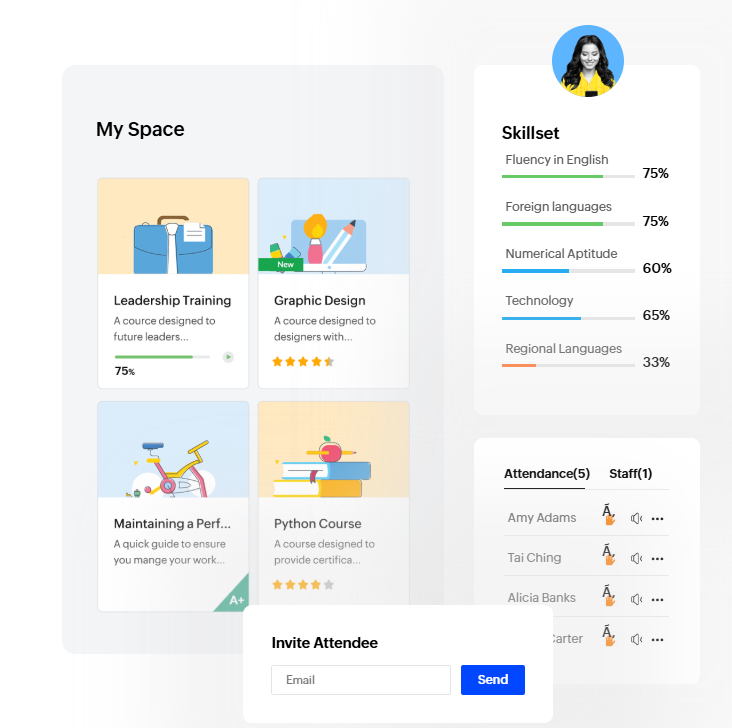
Zoho People is a comprehensive human resource management software simplifying core HR processes.
Core Highlights
- Simplify Core HR Management: Zoho People’s intelligent and efficient software features help HR teams eliminate tedious administrative tasks, streamlining and optimizing core HR processes.
- Optimize Time and Attendance Management: Zoho People’s attendance system accurately tracks working hours, provides error-free reporting, and allows managers to focus on enhancing employee productivity.
- Performance Management: By gaining insights into team and individual performance, uncovering each employee’s skills and potential, and using data-driven insights, Zoho People helps optimize overall organizational performance and aids in nurturing core talents.
Use Cases
- Attendance and Scheduling Management: Optimize resource allocation and reduce scheduling conflicts by tracking employee attendance and shift arrangements in real-time.
- Performance and Goal Setting: Managers can set personalized goals for employees, conduct regular performance evaluations, and provide data-supported recommendations for improvement.
- Employee Document Management: Centralize and manage employee policies, manuals, and contracts, ensuring the security and accessibility of key information.
6. Gusto
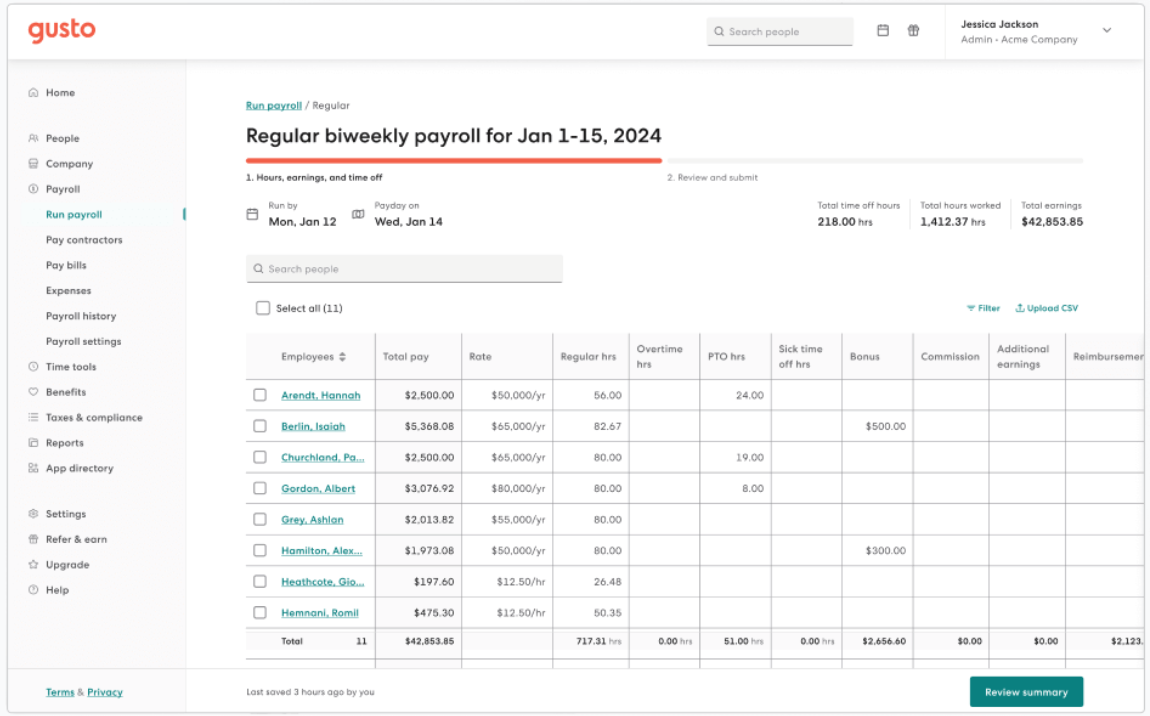
Gusto is an all-in-one HR platform that offers payroll, benefits, tax, and compliance management, designed specifically for small businesses to simplify complex tasks and enhance employee satisfaction.
Core Highlights
- Expert Guidance and Accuracy: Gusto provides expert support, accurately handling complex tasks such as payroll taxes, benefits, and compliance, so users don’t have to face tedious matters alone.
- Easy to Use: Gusto is designed with user needs in mind, featuring a simple and user-friendly interface that saves time and effort.
- All-in-One People Management Platform: Gusto integrates payroll, time tracking, benefits, HR, tax credits, and compliance on a native platform, enabling seamless collaboration across modules.
Use Cases
- Payroll and Tax Management: Supports automated payroll calculations and tax filing processes, reducing cumbersome operations and improving accuracy.
- Employee Benefits Management: Offers various benefit options such as health insurance and retirement plans, making it easier for small businesses to attract and retain talent.
- Onboarding and Employee Management: Simplify employee onboarding procedures and update and manage personnel information in real-time through digital processes.
Conclusion
From NocoBase’s flexible customization to Gusto’s integrated experience, each system has its unique features and can support businesses of different sizes and needs. Whether your company is in the early stages of development or pursuing refined management, now is the time to empower your team with technology and create a more efficient and satisfying work environment!
💡 Read More:
- Top 5 All-in-One Business Software for 2025
- Top 8 Open Source IT Asset Management Software for 2025
- Top 7 Open Source Rapid Development Platform
- Top 8 Open-Source Projects (Rated) to Build Your Own Task Management System
- The Ultimate Guide to Data Transformation Tools
- 5 Best Tools for Building Workflow Automation
